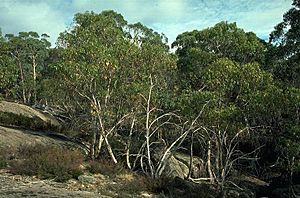Buffalo sallee facts for kids
Quick facts for kids Mt Buffalo sallee |
|
|---|---|
 |
|
| Scientific classification | |
| Genus: |
Eucalyptus
|
| Species: |
mitchelliana
|
| Synonyms | |
|
|
The Mt Buffalo sallee (scientific name: Eucalyptus mitchelliana) is a special type of small tree or mallee. It is also known as Buffalo sallee or Mount Buffalo gum. This plant is found only in one specific area: the Mount Buffalo plateau in Victoria, Australia.
It has smooth bark and leaves that are shaped like a spear. Its flowers are white and grow in small groups. The fruit looks like a cup or a small ball.
Contents
What Does Mt Buffalo Sallee Look Like?
The Mt Buffalo sallee is a tree or a mallee, which means it can grow as a small tree with many stems from the ground. It usually reaches about 15 meters (around 50 feet) tall. It has a special woody lump at its base called a lignotuber. This helps it regrow after fires.
Its bark is smooth and can be grey, light grey, or sometimes green. It peels off in patches, making the trunk look mottled. Young plants have leaves that are opposite each other on the stem. These leaves are spear-shaped, about 6.5 to 11.5 cm long and 0.9 to 2 cm wide. They have a very short stem, called a petiole.
As the plant gets older, its leaves grow alternately along the stem. They are shiny green on both sides and can be straight or slightly curved. These adult leaves are about 7.5 to 15 cm long and 0.6 to 2 cm wide. Their petioles are a bit longer, about 0.8 to 2.1 cm long.
The flower buds grow in star-like groups of seven, nine, or eleven. They are found where the leaves meet the stem (called the axil). These groups of buds are on a short stalk, or peduncle, about 1 to 5 mm long. Each bud sits directly on the stalk without its own little stem (this is called sessile).
Mature buds are shaped like a spindle, about 7 to 10 mm long and 3 to 4 mm wide. They have a cone-shaped or horn-shaped cap called an operculum. The Mt Buffalo sallee flowers between November and January, and its flowers are white.
After flowering, the plant produces woody fruits. These fruits are cup-shaped or like a flattened ball, about 5 to 7 mm long and wide. They are called capsules, and their opening valves are usually at or below the rim.
How Mt Buffalo Sallee Got Its Name
The Mt Buffalo sallee was first officially described in 1919 by a scientist named Richard Hind Cambage. He wrote about it in a scientific journal.
He first tried to name it E. mitchelli, but that name had already been used for a fossil plant. So, he had to give it a new, legal name: Eucalyptus mitchelliana. The "mitchelliana" part of the name honors Sir Thomas Livingstone Mitchell. He was a Surveyor General who explored the area and collected many native plants, including some near Mount Buffalo.
Where Mt Buffalo Sallee Lives
The Mt Buffalo sallee is found only in the subalpine zone of the Mount Buffalo area. This means it lives in a high, cool region. It is quite common in a small part of the northern and north-eastern edge of the plateau.
It often grows among large granite rocks on the edges of slopes. Scientists know of only three groups of these plants in the world.
How Mt Buffalo Sallee Grows in Nature
Both the Mt Buffalo sallee and a similar tree called the snow gum (E. pauciflora) grow in almost pure groups on the Mt Buffalo plateau. This means you can find large areas with mostly just these trees.
The Buffalo sallee prefers to grow in dry, shallow soils. It often lives in places that are very open and windy, especially facing harsh north-easterly winds. Some experts think that the area might need to be disturbed, perhaps by fire, for new groups of these trees to start growing.
Images for kids
-
Leaves of the Mt Buffalo sallee at Bents Lookout in Mount Buffalo National Park.



